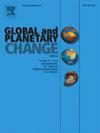北太平洋副热带环流中营养物质的环流通量
IF 4
1区 地球科学
Q1 GEOGRAPHY, PHYSICAL
引用次数: 0
摘要
营养物质通过从深海到光带(EZ)的双周期过程的供应被认为是维持贫营养海洋新生产的主要来源。然而,由于观测资料有限和海洋湍流的动力性质,这种营养物质的湍动通量仍然没有得到充分的限制。在本研究中,我们基于夏季和冬季在西北太平洋副热带环流(NPSG)进行的两次高垂直分辨率的湍流微观结构和营养物质测量,建立了一个综合数据集,包括NO3 - + NO2 - (NOx -)的diapcnal扩散(Fdiff_NOx)和有效的diapcnal通量(Fe_NOx,代表上层水柱的净diapcnal流入)。Fdiff_NOx (Fe_NOx)表现出明显的空间差异,在靠近北赤道流的NPSG南边界和受北太平洋热带副热带模态水影响的NPSG北部,Fe_NOx值较高。相比之下,NPSG中部的数值较低。这些空间变化主要归因于NOx−的垂直浓度梯度。底部的EZ, cruise-averaged Fdiff_NOx (Fe_NOx) 11.7 ± 9.6(11.9 ± 8.6)和8.5 ± 6.1(11.3 ±9.3 )μ摩尔 m 2 d−−1在夏季和冬季,分别显示无关紧要的季节性变化。此外,我们观察到Fdiff_NOx与磷酸盐(Fdiff_DIP)的通量比在夏季和冬季航行时分别为18.2 ± 2.0和13.9 ± 2.0,而在EZ底部的N/P浓度比分别为10.4 ± 1.1和7.4 ± 1.2,这表明代际运输可以缓解NPSG上部的氮限制。值得注意的是,我们发现Fdiff_NOx (Fe_NOx)的对数与NOx -梯度之间存在很强的线性关系。利用这些关系,我们利用世界海洋地图集(WOA23)的营养数据估计了Fdiff_NOx (Fe_NOx)的气候分布。Fe_NOx估计为20.2 ± 16.6 μmol m−2 d−1,贡献了NPSG新生产所需氮的8.5 ± 8.3 %。这些估计比以前的研究略低,但强调了在营养不良的NPSG中,与n2固定和大气沉积相比,下游通量对氮收支的作用不那么重要。相比之下,磷酸盐(Fe_DIP)的有效双周期扩散通量为1.5 ± 1.3 μmol m−2 d−1,贡献了新生产所需磷的18.1 ± 17.9 %,约为NPSG大气磷沉积的10倍。本文章由计算机程序翻译,如有差异,请以英文原文为准。
Diapycnal fluxes of nutrients in the North Pacific Subtropical Gyre
The supply of nutrients via diapycnal processes from depth to the euphotic zone (EZ) is thought to be a main source sustaining new production in oligotrophic oceans. However, such diapycnal fluxes of nutrients remain insufficiently constrained due to limited observations and the dynamic nature of ocean turbulence. In this study, we present a comprehensive dataset of diapycnal fluxes of nutrients, including diapycnal diffusive (Fdiff_NOx) and effective diapycnal fluxes (Fe_NOx, representing the net diapycnal influx to the upper water column) of NO3− + NO2− (NOx−), based on measurements of turbulence microstructure and nutrients with high vertical resolutions from two cruises conducted during summer and winter in the oligotrophic western North Pacific Subtropical Gyre (NPSG). The Fdiff_NOx (Fe_NOx) exhibits evident spatial variations, with higher values observed at the south boundary of the NPSG near the North Equatorial Current and at the northern NPSG influenced by the North Pacific Tropical Subtropical Mode Water. In contrast, lower values are found in the central NPSG. These spatial variations are primarily attributable to the vertical concentration gradient of NOx−. At the base of the EZ, the cruise-averaged Fdiff_NOx (Fe_NOx) are 11.7 ± 9.6 (11.9 ± 8.6) and 8.5 ± 6.1 (11.3 ± 9.3) μmol m−2 d−1 in summer and winter, respectively, displaying insignificant seasonal variations. Moreover, we observed significantly higher flux ratios of Fdiff_NOx to diapycnal diffusive flux of phosphate (Fdiff_DIP), which were 18.2 ± 2.0 and 13.9 ± 2.0, compared to the N/P concentration ratios of 10.4 ± 1.1 and 7.4 ± 1.2 at the base of the EZ during summer and winter cruises, respectively, suggesting that the diapycnal transport could relieve nitrogen limitation in the upper NPSG. Notably, we identified strong linear relationships between the logarithm of Fdiff_NOx (Fe_NOx) and the NOx− gradient. Leveraging these relationships, we estimate the climatological distributions of Fdiff_NOx (Fe_NOx) utilizing nutrient data from the World Ocean Atlas (WOA23). The Fe_NOx is estimated to be 20.2 ± 16.6 μmol m−2 d−1 and contributes to 8.5 ± 8.3 % of the nitrogen required for new production in the NPSG. These estimates are slightly lower than previous studies, but highlight that diapycnal fluxes play a less important role on nitrogen budget compared to N2-fixation and atmospheric deposition in the oligotrophic NPSG. In contrast, the effective diapycnal diffusive flux of phosphate (Fe_DIP) is 1.5 ± 1.3 μmol m−2 d−1, contributing to 18.1 ± 17.9 % of the phosphorus required by new production, and is roughly ten times larger than the atmospheric phosphorus deposition in the NPSG.
求助全文
通过发布文献求助,成功后即可免费获取论文全文。
去求助
来源期刊

Global and Planetary Change
地学天文-地球科学综合
CiteScore
7.40
自引率
10.30%
发文量
226
审稿时长
63 days
期刊介绍:
The objective of the journal Global and Planetary Change is to provide a multi-disciplinary overview of the processes taking place in the Earth System and involved in planetary change over time. The journal focuses on records of the past and current state of the earth system, and future scenarios , and their link to global environmental change. Regional or process-oriented studies are welcome if they discuss global implications. Topics include, but are not limited to, changes in the dynamics and composition of the atmosphere, oceans and cryosphere, as well as climate change, sea level variation, observations/modelling of Earth processes from deep to (near-)surface and their coupling, global ecology, biogeography and the resilience/thresholds in ecosystems.
Key criteria for the consideration of manuscripts are (a) the relevance for the global scientific community and/or (b) the wider implications for global scale problems, preferably combined with (c) having a significance beyond a single discipline. A clear focus on key processes associated with planetary scale change is strongly encouraged.
Manuscripts can be submitted as either research contributions or as a review article. Every effort should be made towards the presentation of research outcomes in an understandable way for a broad readership.
 求助内容:
求助内容: 应助结果提醒方式:
应助结果提醒方式:


